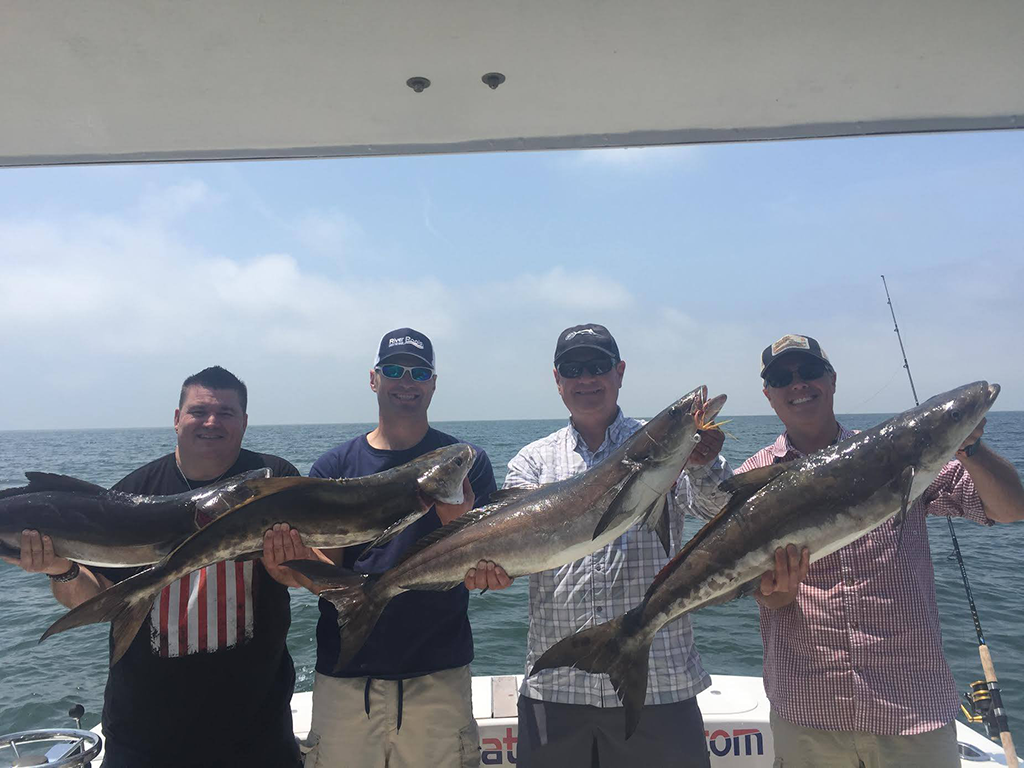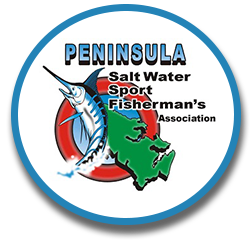
CHESAPEAKE COBIA
Originally published in The Fisherman by Ken Neill
Cobia are fish of many names. They are available throughout the world in tropical and subtropical waters and have many local monikers. Ling is a common name for them along the southeast of the United States. Here, in the Chesapeake, they were known as bonita and you will still hear some old-timers talking about bonita fishing. In today’s information age, these local nicknames are fading out of use in favor of the more universal name “cobia”.
There was always a small dedicated group of cobia fishermen in the Chesapeake Bay and some impressive catches were made. I have an old black and white photograph of George Williams with an impressive catch of cobia. One of the fish was 113 pounds and is listed as a “world record” though it is noted that the catch was not official because the fish was shot with a rifle before being brought into the boat. We don’t shoot our cobia anymore and today many cobia enthusiasts await the arrival of these fish into the Chesapeake Bay each year.
When I started cobia fishing, there were two seasons. The first season was the month of June and the first half of July. During this season, you anchored up and put out a chum slick. During the second half of July, the cobia “spawned” and stopped biting. The second season started in August, after the spawn. During this time, you no longer caught them on a chum slick. You caught them by “running” the buoys and sight casting to them. This was how you caught cobia in the Chesapeake Bay.
A Team
The “A Team” came along and changed much of what we know about cobia. The A Team consisted of the two Dons, Don Lancaster and Don Forman. These two gentlemen were very well known freshwater anglers. Don Lancaster was a fishing guide. Don Forman was a well-known tournament bass angler and he owned the local Bass Pro tackle shop. His store was where we bought all of our fishing tackle when I was a kid and Don Forman was an idol of mine as I was growing up. Later in life, I was his dentist. When he came in, we did not talk about teeth too much but we did talk about fish. At that time, I was doing a lot of cobia fishing, or so I thought. Don Forman and his buddy Don Lancaster set out to catch a cobia. They did not have much experience with these fish but they knew a lot about fishing and they targeted these fish with a passion. They pretty much ignored what we knew about cobia and spent a tremendous amount of time on the water trying different techniques and locations. They made a science of cobia fishing and when the scientists wanted to learn about cobia, they went to the A Team.
Don Forman is no longer with us. You will still find Don Lancaster out there wetting a line and you can read his fishing reports and listen to his weekly radio show. What they taught us continues to be used today. Capt. Jorj Head, has a whole list of “A Team” locations. Whenever he would see the A Team, he would note where they were, the date, water temperature, weather, wind, and tide. If the A Team was there, there was a reason. A lot of good cobia fishermen have a list of “A Team” numbers.
Today we know that cobia arrive to the Chesapeake Bay in spawning condition. They are here for two reasons, to eat and to spawn. They spend the summer doing both. There is not a time when you cannot catch them, you just need to move around with the fish. They are extremely fast growers. Scientists at VIMS were able to take brood stock, provided by the A Team, spawn them and grow the fry to market size in a very short time. The small cobia you release this year will be the trophy you catch next year. They are a hardy fish and survive the catch and release process well, even fish which are gut hooked with the hook left in. It is not uncommon for fish to be recaptured at the same location at about the same date the following year. Individual fish seem to have areas they return to year after year. They will arrive in the bay about May 20 and often the first fish will be caught by anglers targeting drum. By Memorial Day weekend, some targeted catches will be made. When catches are being reported at Hatteras, some fish are already in the bay but it is usually about two weeks after the Hatteras reports start when the Chesapeake Bay fishery really gets going. Dave “Sinker Man” Carpenter says that the cobia bite will be hot when the fireflies come out. This happens sometime during the first two weeks of June. Virginia’s cobia fishery will continue through the month of September.
In general, think shallower for the early season: Grandview, the Rock Pile, Bluefish Rock. Spread throughout the lower bay as the waters warm up. York Spit Light, The Hump, Latimer Shoal, the Inner Middle Ground and numerous hills on the bay bottom are all good spots to chum up a cobia. Most of us will anchor on our favorite spot, put over a chum bucket with some frozen ground bunker, and envision cobia being drawn to our boat from miles away. Jorj thinks of it a different way. He feels that these fish will associate with certain areas, usually a contour change. He is not trying to draw fish from all over the bay, he is trying to catch the fish which are already there. He will anchor on the edge of a hill or other high spot. He thinks these fish will hang out on the down current side of these areas so he wants his chum to fall down the hill to these fish. When the current changes, he will move so that he can present his chum and baits on the down current side of whatever rise he is fishing on. The set up is a black 5-gallon bucket with holes drilled in it as a chum pot. This is weighted and placed down on the bottom. Why black? Well, the A Team tried different colors and black was best. Jorj buys fresh bunker and grinds and freezes his own chum at the beginning of each season. He will sometimes have a chum pot on the surface also but it is the bottom chum pot which is the important one. He will fish 4 rods with fish finder rigs. Two rods are fished close to the boat, near the chum bucket and the other two rods are fished further back. All rods are fished on the bottom though it is a good idea to have a rod ready to cast to a fish which comes up on top to look at your boat. Cobia will eat anything. Any live fish like spot and croaker, cut bunker, and especially eels make great cobia bait. Jorj will leave his reels in free-spool with the clicker on. When a cobia picks up and runs with the bait, the reel is placed in gear. If you are using J-hooks, set the hook. If you are using circle hooks, just let the hook set itself. A northeast blow is not normally an angler favorite but this wind will turn on the cobia bite. This chum fishery will last all summer.
The sight casting fishery is also available all season but it really gets special in August and September. The classic method is to “run the buoys”. Cobia do like structure and you can find them around buoys and the pilings of the CBBT. This is a run and gun approach from structure to structure. If you see cobia, you cast a jig or a live bait to it and sometimes it is worth a cast or two even if you don’t see one. Another approach which is very effective on calm days is to just cruise around the mouth of the bay. The Baltimore Channel on either side of the CBBT is a good area for this. You will often see cobia swimming around in open waters. Cast an eel out in front of it and let the fish eat it. If you are casting jigs, work them fast as this often elicits a reaction strike.
Sidebars:
Cobia Get Big
The world record cobia is a 135 pound 9 ounce fish caught off of Australia. The current Virginia record was caught in 2006 by Joseph Berberich, II at York Spit Light. His fish weighed 109 pounds. The Virginia Saltwater Fishing Tournament will issue a trophy citation for a 55-pound cobia or for a 50-inch fish which is released.
Regulations
Anglers fishing in Virginia are allowed to keep one cobia per day with a minimum size of 37 inches total length.
Some Chesapeake Bay Cobia Spots
Latimer Shoal 37 08′ N, 076 00′ W
Baltimore Channel Hill 37 07′ N, 076 06′
W Hump 37 10.6′ N, 076 10.3′ W
Rock Pile 37 05.25′ N, 076 16.20′ W
Bluefish Rock 37 04.8′ N, 076 13.6′ W
York Spit 37 12.1′ N, 076 15.3′ W
